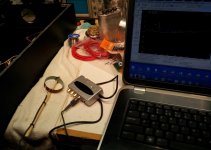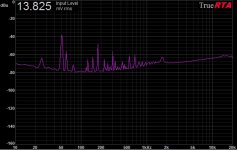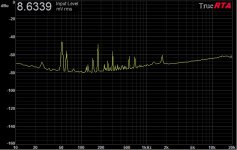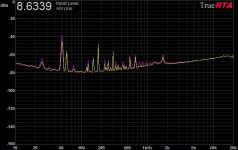Just wanted to relate an excellent experience I just had with Lars Clausen of NewclassD. I am using their softstart module on the 833 B+ circuit for a few reasons:
It can handle the load
It has a built-in DC and EMI filter
It has the option of using a low voltage pushbutton to turn it on and off from the front panel, so I can use the mains switch to turn on the driver, bias and filament circuits, then use the pushbutton after a suitable delay to start the 833 B+.
The only issue is that it is set to default to always on, and to remember what it was set at in case of a power failure. So...if there is a power failure, or if the mains power is switched off with the B+ still on, when power is restored the B+ would be instantly on. This is fine for a class D amp, such as it was designed for, but not for this amp!
I sent NewclassD an email about this and after some discussions Lars suggested that he could program a new controller chip and send it to me, with the default changed to OFF. All I need to do is solder it in and all should be good! No charge for the programming or the shipping, either!
Great customer service, Lars!
Received the smd chips yesterday and soldered them in last night. Works like a charm! So the 833 B+ soft start is off until turned on. Much safer.
I wired up the fan transformer and DC supply and the fan today. The fan is an 80mm x 80mm x 25mm Sunon Maglev, rated at 28dB noise, 33cfm airflow at 12V, placed under the 833C to cool it while drawing hot air from the chassis. I made a gasket from silicone sheet material to go between the fan and the underside of the chassis lid, and used neoprene washers under the screw heads, all for the sake of vibration isolation.
When I fired it up I was surprised by how much the chassis magnified the sound, like a sounding board; out of the chassis the fan was very quiet. At 12V it was definitely too loud, audible from a few feet away! So, I started dialing down the voltage (glad I used an adjustable regulator) and found that 7V still gave good airflow while being MUCH quieter. 9V and up was too loud, 8V was OK, but 7V was inaudible unless I was within inches of the fan.
I'll leave it at 7V for now, and see how much if any microphonics issues I get from the 6E5P. I can go even lower in voltage (the fan is rated down to 4.5V), but don't want to degrade the cooling too much. Everything's a compromise...
When I fired it up I was surprised by how much the chassis magnified the sound, like a sounding board; out of the chassis the fan was very quiet. At 12V it was definitely too loud, audible from a few feet away! So, I started dialing down the voltage (glad I used an adjustable regulator) and found that 7V still gave good airflow while being MUCH quieter. 9V and up was too loud, 8V was OK, but 7V was inaudible unless I was within inches of the fan.
I'll leave it at 7V for now, and see how much if any microphonics issues I get from the 6E5P. I can go even lower in voltage (the fan is rated down to 4.5V), but don't want to degrade the cooling too much. Everything's a compromise...
I was curious as to how much electrical noise the DC Brushless Fan emitted, so I built an EMI probe from an old speaker voice coil, a chop stick, my PC with True RTA and a USB interface box. See picture #1.
I tested the probe by holding it near my Variac and the fluorescent lights, and yup, it showed LOTS of noise, which decreased rapidly as I moved it away...good.
Then I put the probe at approximately the position of the amp input circuit and measured the EMI with the fan OFF and then turned ON. Pictures 2 and 3 tell the story - there is quite a bit of noise emitted by the fan, and it does reach the input circuit. Uh-oh. I thought that since only the side of the fan was facing the inputs there might not be an issue; looks like I was wrong about that, there's actually more emission from the sides then from the front or back of the fan.
So I then placed a piece of TI-Shield (grounded to chassis) between the fan and the probe, and it did help decrease the noise significantly - Pictures 4 and 5 show the noise with the shield and an overlay of the noise with and without the shield.
Soooo...I may have an issue I need to solve. Certainly, I will wrap the fan perimeter with at least one layer of TI-Shield, maybe two or three. I may also need to consider shielding the input circuits. Or I could just forgo the fan altogether if the problem proves intractable; guess I won't know for sure until I hook up the input circuit and test it.
I don't know how well the amount of noise picked up by my noise probe correlates to how much will be picked up by the input circuit - perhaps the probe is more sensitive (I hope)? Given the high impedance in the inputs, however, that's probably wishful thinking.
I tested the probe by holding it near my Variac and the fluorescent lights, and yup, it showed LOTS of noise, which decreased rapidly as I moved it away...good.
Then I put the probe at approximately the position of the amp input circuit and measured the EMI with the fan OFF and then turned ON. Pictures 2 and 3 tell the story - there is quite a bit of noise emitted by the fan, and it does reach the input circuit. Uh-oh. I thought that since only the side of the fan was facing the inputs there might not be an issue; looks like I was wrong about that, there's actually more emission from the sides then from the front or back of the fan.
So I then placed a piece of TI-Shield (grounded to chassis) between the fan and the probe, and it did help decrease the noise significantly - Pictures 4 and 5 show the noise with the shield and an overlay of the noise with and without the shield.
Soooo...I may have an issue I need to solve. Certainly, I will wrap the fan perimeter with at least one layer of TI-Shield, maybe two or three. I may also need to consider shielding the input circuits. Or I could just forgo the fan altogether if the problem proves intractable; guess I won't know for sure until I hook up the input circuit and test it.
I don't know how well the amount of noise picked up by my noise probe correlates to how much will be picked up by the input circuit - perhaps the probe is more sensitive (I hope)? Given the high impedance in the inputs, however, that's probably wishful thinking.
Attachments
One other possibility is to put the fan on TOP of the lid instead of under it. That would move it further from the vicinty of the input circuits, put the lid in between as another shield, and probably also decrease the mechanical noise resonating in the box. It would be near the 6E5P, but that's easy to shield using a tube shield. I'll have to look into that...after football, of course.
OK, so I tried it with the fan on top of the box and, indeed, it does decrease the noise in the area of the input circuits, about as much as adding the TI-Shield did when the fan was inside the box. See Picture.
So if I put the fan on top of the box and wrap it in TI-Shield and shield the 6E5P I should be able to lower the likelihood of noise pickup substantially.
I think I will also order a Sanyo Denko low noise fan and see how that stacks up to the Sunon in terms of mechanical and electrical noise.
So if I put the fan on top of the box and wrap it in TI-Shield and shield the 6E5P I should be able to lower the likelihood of noise pickup substantially.
I think I will also order a Sanyo Denko low noise fan and see how that stacks up to the Sunon in terms of mechanical and electrical noise.
Attachments
I just ordered a Noctua low noise fan (31cfm, 17dB noise!) which should arrive next week. I'll test that both for audible and electrical noise the same way I tested the (much cheaper) Sunon. It should be interesting to see how the Noctua ($14.95) compares to the Sunon ($4.95).
PS: the Noctua has a 150,000 hour MTBF spec, compared to 60,000 hours for the Sunon. That's a lot of listening!
.
PS: the Noctua has a 150,000 hour MTBF spec, compared to 60,000 hours for the Sunon. That's a lot of listening!
.
Last edited:
Fan Noise
You have two things that are going to generate noise,one is much more intrusive than the other...a low noise fan is not the issue really and anything up to 28 db is bearable...the real culprit is the way the Fan is mounted and the acoustic coupling as a consequence of it.......the only way to limit this is to mount the Fan in such a way that it has minimal contact with anything else in particular metal cabinets or the chassis...as these will surely resonate.......the best way to mount the Fan is on Fishing Line strung at each corner and then tied to the cabinet...this will provide the bear minimum of physical contact....I have tried this a number of times in the past and found it to very effective.
You have two things that are going to generate noise,one is much more intrusive than the other...a low noise fan is not the issue really and anything up to 28 db is bearable...the real culprit is the way the Fan is mounted and the acoustic coupling as a consequence of it.......the only way to limit this is to mount the Fan in such a way that it has minimal contact with anything else in particular metal cabinets or the chassis...as these will surely resonate.......the best way to mount the Fan is on Fishing Line strung at each corner and then tied to the cabinet...this will provide the bear minimum of physical contact....I have tried this a number of times in the past and found it to very effective.
I just ordered a Noctua low noise fan (31cfm, 17dB noise!) which should arrive next week. I'll test that both for audible and electrical noise the same way I tested the (much cheaper) Sunon. It should be interesting to see how the Noctua ($14.95) compares to the Sunon ($4.95).
PS: the Noctua has a 150,000 hour MTBF spec, compared to 60,000 hours for the Sunon. That's a lot of listening!
.
Knauer uses Sunon brand fans in their UV detectors and I can tell you we replace them all the time. Sunon is a very poor quality product. Very interested in seeing how well the Noctua fan does.
I have drawn a diagram which may help you
Thanks. If I can't work things out as it is now, I'll consider that. Thing is, I'd have to cut up the chassis to do that and I'd rather not unless absolutely necessary.
How about using these?
.gif)
Actually, I believe the Noctua NF-R8 comes with four of those soft mounts in the box, at least that's what one of the reviews I read said.
It should be interesting to see how the Noctua ($14.95) compares to the Sunon ($4.95).
PS: the Noctua has a 150,000 hour MTBF spec, compared to 60,000 hours for the Sunon. That's a lot of listening!
There are certain military applications which require extremely low noise over the entire very long life of the fan.
But r.r.p. was c. $800 last time I bought one new - look for surplus!
I see a problem with those rubber mounts. It can create an air path around the fan. Kind of like running a woofer without a baffle. You may need to use some kind of weather stripping to create a seal for the fan so your not just spinning your wheels. Or fan rather, LOL.
Other then that its looking really nice.
Other then that its looking really nice.
Fan
Hi Magz,
Understand you not wanting to cut up the chassis. The way I have suggested seems a bit Micky Mouse but it does work.
Hi Magz,
Understand you not wanting to cut up the chassis. The way I have suggested seems a bit Micky Mouse but it does work.
Since the fan is an important piece of this amp, cooling both the 833C output tube and the components in the chassis, failure must be detected before the excess heat melts down the 833C or overheats the components in the case.
I'm thinking of building the circuit in the attached link to sound an alarm or light a red LED in the case of fan failure. It looks simple enough, and makes use of the third wire (tachometer output) that's already present in the Noctua fan lead.
PC Fan Failure Alarm
Looks like some cheap insurance.
.
I'm thinking of building the circuit in the attached link to sound an alarm or light a red LED in the case of fan failure. It looks simple enough, and makes use of the third wire (tachometer output) that's already present in the Noctua fan lead.
PC Fan Failure Alarm
Looks like some cheap insurance.
.
Last edited:
I see a problem with those rubber mounts. It can create an air path around the fan.
They are pretty common in PC's for mounting the fan to the CPU cooling tower. I have a setup like this on one of my overclocked PC's. Some air might escape, but most goes through the fins on the tower.
Just make it "fail safe"- that is, if anything fails (eg comes unplugged) the alarm goes off.Looks like some cheap insurance.
It's the normal way to wire up monitors on fans used for air exchange in dangerous environments (eg battery compartments)
ps - if truly paranoid you also put an overtemperature switch (N/C) in series with main power switch
Last edited:
I have 2 Noctua fans in my TubeLab SE. I never thought to measure the noise they could be generating. On the other hand, the amp is dead quiet - so no need to chase dragons that don't exist in my case. One is a general enclosure fan, and the other is a tiny 40mm to spot cool my regulator heat sink.
If I get a chance, I'll take some photos of them mounted. One precaution; which could be a PITA with a super heavy case... You need to be able to inspect and clean the fans regularly. Forced air has a habit of packing your components with dust bunnies.
If I get a chance, I'll take some photos of them mounted. One precaution; which could be a PITA with a super heavy case... You need to be able to inspect and clean the fans regularly. Forced air has a habit of packing your components with dust bunnies.
- Home
- Amplifiers
- Tubes / Valves
- The Midlife Crisis - My 833C Amp Build






